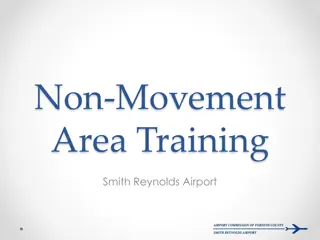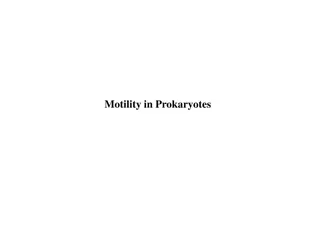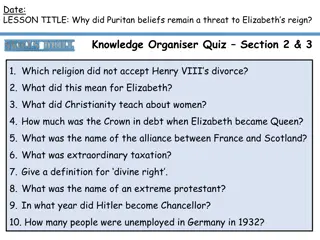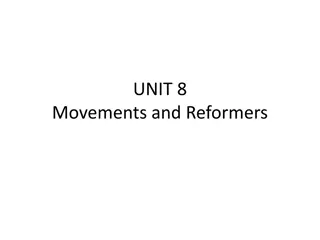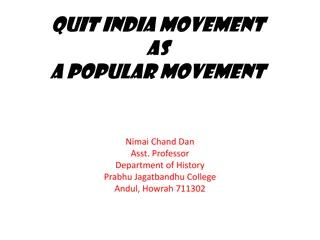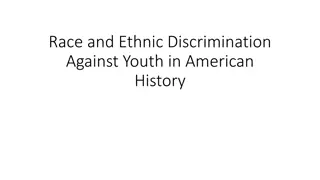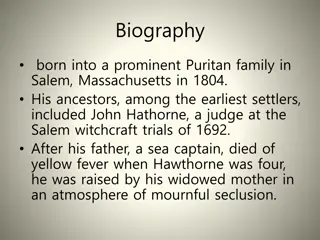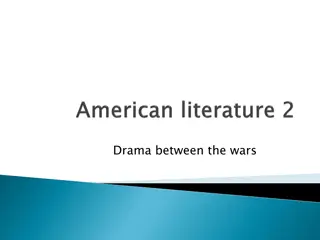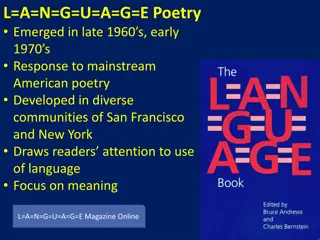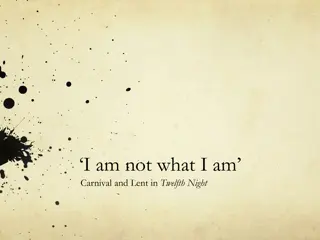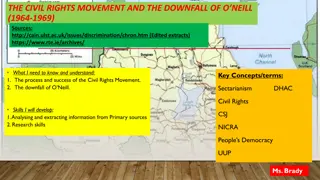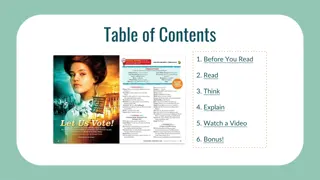
Puritan Movement in the Late 16th and Early 17th Centuries
Explore the Puritan Movement in the late 16th and early 17th centuries, its goals, conflict with the monarchy, influence on society, and notable figures like Oliver Cromwell. Learn about their religious reform efforts, political influence, and literary contributions that shaped English society during this transformative period.
Download Presentation

Please find below an Image/Link to download the presentation.
The content on the website is provided AS IS for your information and personal use only. It may not be sold, licensed, or shared on other websites without obtaining consent from the author. If you encounter any issues during the download, it is possible that the publisher has removed the file from their server.
You are allowed to download the files provided on this website for personal or commercial use, subject to the condition that they are used lawfully. All files are the property of their respective owners.
The content on the website is provided AS IS for your information and personal use only. It may not be sold, licensed, or shared on other websites without obtaining consent from the author.
E N D
Presentation Transcript
THE PURITAN MOVEMENT LATE SIXTEENTH AND EARLY SEVENTEENTH CENTURIES
Puritan Goals The movement was primarily religious, but due to the close ties in England between religion and government, it affected politics and society as well. The Puritans immediate goal was to reform, or purify, the Church of England by eliminating certain Roman Catholic traditions. As protestants, the Puritans rejected the belief that divine authority is channeled though one particular person, such as a pope. Instead they believed individuals had the power to receive spiritual enlightenment directly from the teachings of the bible.
Puritan Goals Puritans also objected to the top-to- bottom structure of the national church, in which the king or queen appointed bishops, who, in turn selected local ministers. Puritans wanted a bottom-to-top structure in which congregations chose their own ministers. Puritans spread their vision through their writings political pamphlets, books of religious instruction, and stirring sermons, which were published and widely read.
Conflict with the Monarchy While Queen Elizabeth I and her successor King James I generally tolerated the Puritans, King Charles I, James son and successor, did not. Charles angered Puritans, and moderate Protestants alike by supporting plans to restore some Roman Catholic traditions and strengthen the power of the bishops. In response, some Puritans left England for America. Those who stayed steadily gained power in Parliament.
Elizabeth I James I Charles I Charles II
A New Government http://olivercromwellfans.com/files/2008/12/oliver-cromwell3.jpg Political tension soon erupted into civil wars, and in 1649 the king was found guilty of treason and beheaded. A new government, the Commonwealth, headed by the Puritan Oliver Cromwell, took over.
Puritan Influence Once in power, the Puritans tried to make English society conform to their strict beliefs. They forbade the celebration of Christmas and Easter. They prohibited activities such as playing chess and dancing. All public theaters were closed, and writers risked being censored unless their work supported the Puritan way of life.
Puritan Influence Despite these restrictions, the Puritan era did produce enduring literature. John Bunyan s Pilgrim s Progress was one of the most influential books of its time. John Milton, best known today as the author of Paradise Lost, a masterpiece epic of poetry, wrote fiery pamphlets in support of the Puritan cause as well as pamphlets supporting religious and civil liberties.
End of the Commonwealth The unpopular Commonwealth ended in 1660, when the monarchy was restored, but the Puritans left their mark. Their religious and political beliefs influenced attitudes in both England and America for centuries to come.


